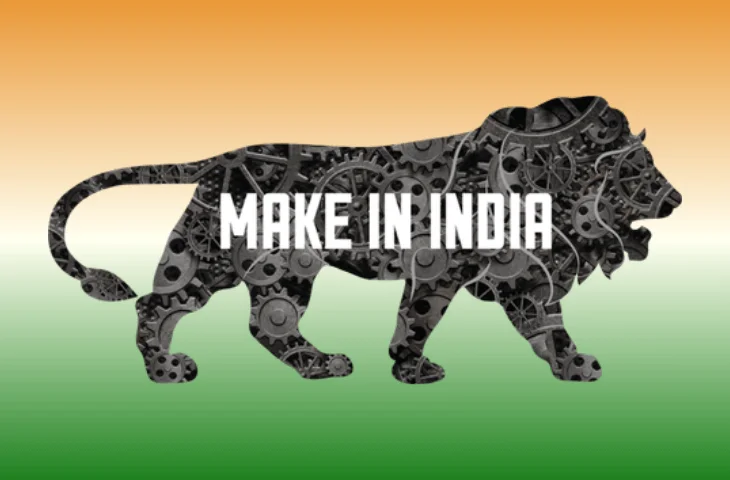The Make in India initiative was launched by the Government of India on 25th September 2014, under the leadership of Prime Minister Narendra Modi. The program aims to transform India into a global design and manufacturing hub, attracting both domestic and foreign investments while promoting innovation, entrepreneurship, and job creation.
Initially, India faced economic challenges, including a decline in GDP growth and weakening global investor confidence. The Make in India initiative emerged as a strategic response to revitalize India’s manufacturing sector, improve Ease of Doing Business, and enhance the country’s global competitiveness.
The initiative aligns closely with the broader vision of Atmanirbhar Bharat (Self-Reliant India), seeking to reduce import dependency, strengthen exports, and create a sustainable industrial ecosystem.
What are the Core Objectives of Make in India?
Make in India is guided by several key objectives, which aim to boost economic growth and job creation:
| Objective | Details |
| Encourage Manufacturing Growth | Aim for a 12-14% annual growth rate in the manufacturing sector and increase its share of India’s GDP to 25% by 2025. |
| Foster Domestic and Foreign Investment | Simplify regulations and improve the business environment to attract FDI across sectors like defense, electronics, textiles, and automobiles. |
| Generate Employment Opportunities | Create 100 million jobs in the manufacturing sector by 2025, focusing on youth employment. |
| Develop Modern Infrastructure | Build industrial corridors, smart cities, high-speed communication networks, and logistics facilities to support industrial growth. |
| Promote Innovation and Skill Development | Emphasize innovation, skill enhancement, and entrepreneurship in alignment with Skill India and Startup India initiatives. |
What are the Strategic Pillars of Make in India?
The initiative is structured around four main pillars to ensure systematic growth:
| Pillar | Details |
| New Processes | The government has shifted from a regulator to a facilitator, simplifying business procedures and promoting entrepreneurship. Policies like the Insolvency and Bankruptcy Code, GST, and Jan Vishwas Act have improved the regulatory environment. |
| New Infrastructure | Development of industrial corridors, smart cities, and modern transportation networks supports manufacturing and logistics. |
| New Sectors | Key sectors such as defense, railways, insurance, construction, and medical devices have been opened up for higher levels of FDI, encouraging investments and technology transfer. |
| New Mindset | Collaborative engagement between the government and industry ensures a supportive ecosystem for businesses while focusing on innovation and sustainability. |
What are the Major Initiatives Under Make in India?
To achieve its objectives, the Make in India initiative has launched several programs:
1. Make in India 2.0
Launched in 2021, this phase focuses on 27 key sectors, including electronics, aerospace, pharmaceuticals, and defense. It emphasizes high-value manufacturing and Industry 4.0 adoption, such as automation, AI, and smart manufacturing technologies.
2. Production-Linked Incentive (PLI) Schemes
The PLI schemes provide financial incentives to boost domestic manufacturing and exports across 14 sectors. By 2024, PLI programs have generated around 8 lakh jobs with investments exceeding ₹1.23 lakh crore.
3. PM GatiShakti
The PM GatiShakti initiative aims to strengthen multi-modal and last-mile connectivity, integrating railways, roads, ports, airports, waterways, and mass transport. This initiative is pivotal for achieving a $5 trillion economy target.
Check Out: Complete List of Important Schemes for NABARD Grade A Exam
4. Semicon India Programme
Approved in 2021, this program seeks to develop a sustainable semiconductor and display manufacturing ecosystem to reduce dependency on imports.
5. National Logistics Policy (NLP)
The NLP focuses on reducing logistics costs, enhancing India’s Logistics Performance Index, and building a data-driven decision support system.
6. Startup India & Skill Development
Make in India synergizes with Startup India and Skill India programs to promote innovation, entrepreneurship, and skill enhancement in emerging technologies.
7. Tax and Digital Reforms
Reforms like GST, UPI, and digitalization of approvals under National Single Window System have improved the ease of doing business, reducing bureaucratic hurdles and enhancing investor confidence.
Get ready to crack government job exams with leading educators
What are the Major Achievements of the Make in India Scheme?
The Make in India initiative has contributed to economic growth in various ways, such as:
1. Foreign Direct Investment (FDI)
India has seen a record FDI inflow of $81.97 billion in 2021–22, reflecting global investor confidence. Liberalized policies across defense, railways, and construction have attracted both domestic and international companies.
2. Manufacturing Milestones
- India has emerged as the second-largest mobile phone manufacturer, producing 99% of domestic smartphones.
- The defense sector achieved self-reliance with platforms like INS Vikrant, Dhanush artillery guns, LCA Tejas, and MBT Arjun.
- Annual toy production reaches 400 million units, and India is the 4th largest renewable energy producer globally.
3. Export Growth
- Merchandise exports reached $437 billion in 2024, including high-value products like pharmaceuticals, defense equipment, and dairy products.
- India supplies nearly 60% of the world’s vaccines, strengthening its global role in healthcare.
4. Innovation and R&D
- India climbed 42 ranks in the Global Innovation Index, ranking 39th in 2024.
- Initiatives like Anushandhan National Research Foundation (ANRF) promote early-stage research and IP development.
What are the Challenges and Concerns?
Despite progress, Make in India faces several challenges:
- Infrastructure Gaps: Limited transportation, logistics, and power supply increase production costs and reduce industrial competitiveness.
- Slow Job Growth: Manufacturing employment fell from 51 million in 2017 to 35 million in 2023, missing the target of 100 million jobs.
- Unmet GDP Targets: The manufacturing sector contributes only 17–18% of GDP, below the 25% goal.
- Regulatory Hurdles: Complex labor laws, land acquisition issues, and bureaucratic delays continue to hinder business operations.
- Dependence on Imports: Key sectors such as electronics and defense heavily rely on imported components, restricting self-reliance.
- Low R&D Investment: India invests only 0.7% of GDP in research and development, much lower than the global average of 1.8%.
- Supply Chain Vulnerabilities: COVID-19 exposed weaknesses in global supply chains, emphasizing the need for local sourcing and stronger domestic networks.
Also Check: List of Government Schemes of India
Key Takeaway
| Aspect | Key Highlights |
| Launched | 25th September 2014 |
| Objective | Transform India into a global manufacturing hub |
| Focus Sectors | 25 priority sectors (Automobiles, IT, Pharmaceuticals, etc.) |
| FDI Reforms | Liberalized in Defense, Railways, Construction, Medical Devices |
| Employment Target | 100 million jobs by 2025 |
| Manufacturing GDP Contribution | Target 25% by 2025 (Currently ~17.7%) |
| Major Initiatives | Make in India 2.0, PLI, PM GatiShakti, Semicon India Program |
| Export Achievement | $437 Bn merchandise exports (2024) |
| Innovation | 42-rank jump in Global Innovation Index; ANRF established |
| Key Challenges | Infrastructure gaps, skill shortage, import dependency, low R&D investment |
Questions on Make in India
- When was the Make in India initiative launched?
A) 2010
B) 2012
C) 2014
D) 2016
E) 2018 - What is the target contribution of the manufacturing sector to GDP by 2025?
A) 20%
B) 22%
C) 25%
D) 30%
E) 35% - How many sectors does Make in India 2.0 focus on?
A) 20
B) 25
C) 27
D) 30
E) 15 - Which of the following is a major initiative under Make in India?
A) Startup India
B) PM GatiShakti
C) Skill India
D) ANRF
E) All of the above - India is the second-largest manufacturer globally in which sector?
A) Automobiles
B) Mobile Phones
C) Textiles
D) Pharmaceuticals
E) Renewable Energy
Also Read:
- What percentage of the world’s vaccines does India supply?
A) 40%
B) 50%
C) 60%
D) 70%
E) 80% - Which defense platform was India’s first indigenously built aircraft carrier?
A) INS Chakra
B) INS Vikrant
C) INS Vikramaditya
D) INS Arihant
E) INS Shivalik - What is the current R&D expenditure-GDP ratio in India?
A) 0.5%
B) 0.7%
C) 1%
D) 1.5%
E) 2% - Which program aims to develop a semiconductor ecosystem in India?
A) Startup India
B) Semicon India Programme
C) PM GatiShakti
D) PLI Scheme
E) National Logistics Policy - Which of the following reforms improved the Ease of Doing Business in India?
A) GST
B) Insolvency and Bankruptcy Code
C) Jan Vishwas Act
D) National Single Window System
E) All of the above
Answer Key:
| Question Number | Answer | Question Number | Answer |
| 1 | C | 6 | C |
| 2 | C | 7 | B |
| 3 | C | 8 | B |
| 4 | B | 9 | B |
| 5 | B | 10 | E |
- MISHTI Scheme, India’s Initiative to Restore Mangrove Ecosystems
- National Green Hydrogen Mission Features, Objectives, and Benefits
- Paramparagat Krishi Vikas Yojana, Transforming India’s Organic Farming
- Mission on Integrated Development of Horticulture NHM and HMNEH
- Swachh Bharat Mission, India’s Journey Towards Cleanliness and Hygiene
- SAGY, A Step Towards Holistic Development of Indian Villages

Hi, I’m Aditi. I work as a Content Writer at Oliveboard, where I have been simplifying exam-related content for the past 4 years. I create clear and easy-to-understand guides for JAIIB, CAIIB, and UGC exams. My work includes breaking down notifications, admit cards, and exam updates, as well as preparing study plans and subject-wise strategies.
My goal is to support working professionals in managing their exam preparation alongside a full-time job and to help them achieve career growth.
